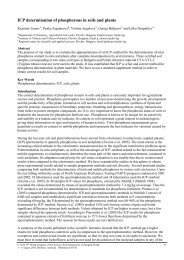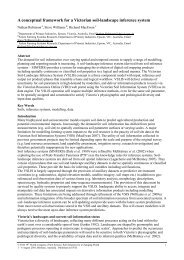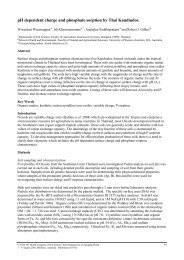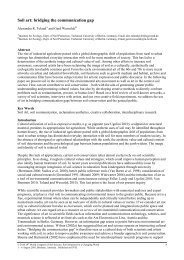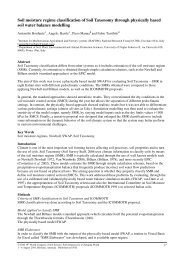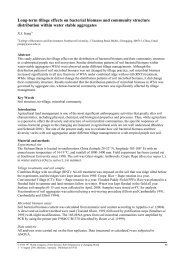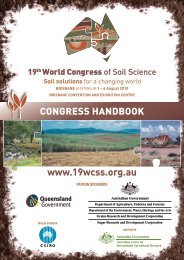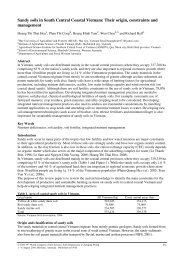Nguyen Quang Chon - International Union of Soil Sciences
Nguyen Quang Chon - International Union of Soil Sciences
Nguyen Quang Chon - International Union of Soil Sciences
Create successful ePaper yourself
Turn your PDF publications into a flip-book with our unique Google optimized e-Paper software.
Table 3. Effect <strong>of</strong> Si application on the charge characteristics, P availability and PBI <strong>of</strong> a Pingin series subsoil<br />
incubated for 7 days at 40 o C near field capacity.<br />
Amendements Si added pH (CaCl2) pH 0 PZNC CEC b CEC t AEC Colwell P PBI<br />
(kg /ha) (1:10)<br />
(cmol c /kg)<br />
Control<br />
Ca-Si<br />
Ac-Ca-Si<br />
Mg-Si<br />
Ac-Mg-Si<br />
0<br />
420<br />
210<br />
420<br />
210<br />
4.49<br />
4.88<br />
4.54<br />
4.81<br />
4.61<br />
5.63<br />
5.41<br />
5.41<br />
5.43<br />
5.32<br />
4.28<br />
4.43<br />
4.35<br />
4.42<br />
4.14<br />
0.09<br />
0.19<br />
0.11<br />
0.17<br />
0.21<br />
0.11<br />
0.21<br />
0.14<br />
0.18<br />
0.23<br />
0.06<br />
0.10<br />
0.01<br />
0.11<br />
0.11<br />
33.5<br />
35.8<br />
33.1<br />
33.6<br />
31.5<br />
838<br />
798<br />
812<br />
816<br />
784<br />
Although Colwell P was not responsive to applied silicates, PBI decreased (Table 3). Hence soil P sorption<br />
capacity may be reduced by applying silicate.<br />
Discussion<br />
The application <strong>of</strong> FMP and raw silicate materials (Ca-Si and Mg-Si) increased soil pH accounting for the<br />
majority <strong>of</strong> change in soil CEC b (Figure 1, Table 3). Increased soil pH following application <strong>of</strong> phosphate or<br />
silicate ions to ferric soils is most likely associated with release <strong>of</strong> hydroxide ions following specific<br />
adsorption reactions (Smyth and Sanchez 1980). Hence the most effective way to increase charge in geric<br />
soils is to increase soil pH rather than adjust pH 0 .<br />
The exception to this trend occurred following application <strong>of</strong> acidulated Mg-Si where minimal change in pH<br />
was observed, yet CEC b more than doubled (Table 3). The majority <strong>of</strong> the change in CEC b for this<br />
amendment may be associated with lowering <strong>of</strong> the pH 0 . The pH 0 <strong>of</strong> treated soils shifted to lower values<br />
compared to the incubated control; this can be attributed to the specifically adsorbed anions HPO 4 2- and<br />
SiO 4 2- that are released from FMP and silicate amendments (Qafoku et al. 2004; Uehara and Gillman 1981;<br />
Zhang and Zhao 1997). However, the pH 0 <strong>of</strong> all incubated soils, including the control, were higher than the<br />
pH 0 value <strong>of</strong> the non-incubated baseline soil. A number <strong>of</strong> factors may be involved with shift in pH 0<br />
following incubation. First, the presence <strong>of</strong> Ca in the amended treatments may result in charge reversal due<br />
to Ca adsorption into the Stern layer (Uehara and Gillman 1981). Wann and Uehara (1978) observed similar<br />
results following Ca-Si amendments on Oxisols. Second, organic carbon coating Fe and Al oxides might<br />
have oxidised/mineralised during incubation at 40 o C, thus exposing surfaces with a relatively higher pH 0 .<br />
This explanation seems less likely because the test soil is a subsoil, but organic C analyses to compare<br />
incubated with non-incubated soils remain to be undertaken.<br />
The interesting result <strong>of</strong> this study is that only the pH 0 value <strong>of</strong> FMP applied at 300 mg P /kg was lower than<br />
soil pH. This might be caused by the dual effects <strong>of</strong> P and Si anions that were released from FMP fertiliser.<br />
The relationship between soil pH and pH 0 determines the magnitude <strong>of</strong> net charge; therefore, on one hand the<br />
CEC in this treatment was greatly increased, and on the other hand PZNC was greatly decreased compared to<br />
the other treatments. In addition, FMP application brought about an increase in Colwell P and reduced PBI <strong>of</strong><br />
the soil. This is a logical effect <strong>of</strong> the P content in FMP and also the competitive effect <strong>of</strong> Si content in FMP<br />
with P on the adsorptive sites.<br />
Among silicate sources, although Ac-Mg-Si did not increase soil pH as much as Ca-Si and Mg-Si, it was the<br />
most responsive amendment in terms <strong>of</strong> reducing pH 0 and increasing CEC b <strong>of</strong> the soil. Also, Ac-Mg-Si did<br />
not increase Colwell P, but it decreased PBI to the lowest value compared to the other silicate sources (Table 3).<br />
These effects can be explained by more available Si being released to the soil from this product than the others,<br />
as salt extractable Si <strong>of</strong> Ac-Mg-Si was much higher than that in the other silicate amendments (Table 2).<br />
Conclusion<br />
The Pingin series subsoil has similar charge characteristics to those <strong>of</strong> the geric Ferralsols <strong>of</strong> the uplands <strong>of</strong><br />
Vietnam in terms <strong>of</strong> very low CEC and high pH 0 . The application <strong>of</strong> FMP fertiliser not only overcomes a<br />
potential phosphorus deficiency, but through increasing pH may also increase soil charge and increase<br />
nutrient retention. Applying Ca-Si and Mg-Si materials can also rectify the problem <strong>of</strong> the geric property in<br />
highly weathered tropical soils by increasing the nutrient holding capacity <strong>of</strong> the soil and increasing P<br />
availability to the plant by the adsorptive competition <strong>of</strong> Si with P for sorption sites.<br />
© 2010 19 th World Congress <strong>of</strong> <strong>Soil</strong> Science, <strong>Soil</strong> Solutions for a Changing World 58<br />
1 – 6 August 2010, Brisbane, Australia. Published on DVD.



